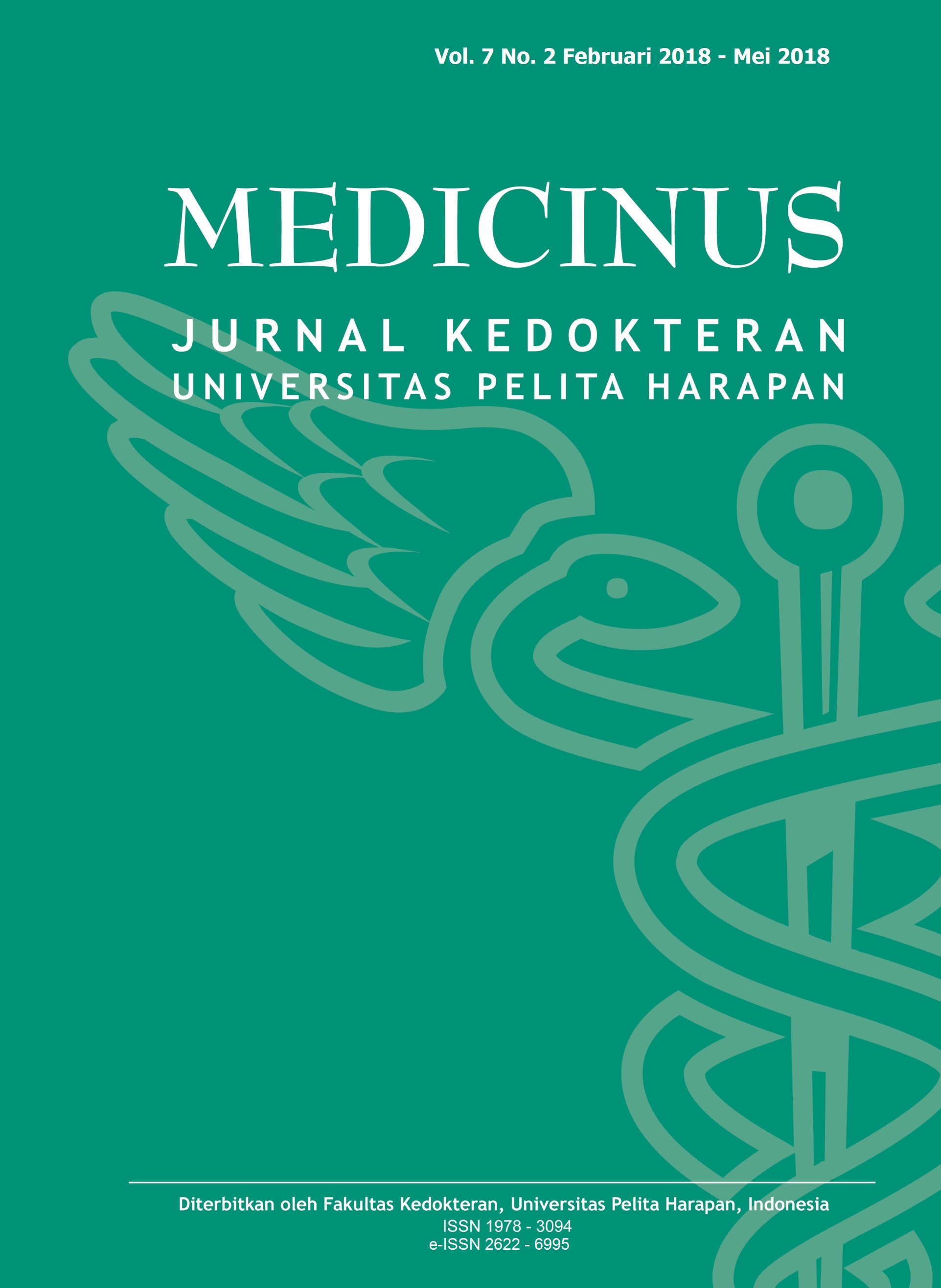Randomized Trial Comparing Adjuvant Intravitreal Triamcinolone Acetonide 2mg and Bevacizumab 12,5mg for Diabetic Macular Edema
DOI:
https://doi.org/10.19166/med.v7i2.1792Keywords:
Adjuvant, Intravitreal, Triamcinolone Acetonide 2 mg, Bevacizumab, DMEAbstract
Objectives
To evaluate the efficacy and safety of Intravitreal Triamcinolone Acetonide (IVTA) 2 mg and Bevacizumab (IVB) 12,5 mg for adjuvant therapy of Diabetic Macular Edema (DME)
Design
This was a prospective, randomized clinical trial. Each participants with DME was randomized to received single intravitreal injection of IVTA or IVB and then being followed until fourth week after injection. The efficacy parameters were the improvement in Best Corrected Visual Acuity (BCVA) in logMAR and Standardized Central Macular Thickness (SCMT) by Optical Coherence Tomography. The safety parameters were the Intra Ocular Pressure (IOP) and Posterior Capsular cataract progression using LOCSIII criteria.
Results
Twenty five eyes of 20 participants were randomly assigned to receive IVTA 2 mg (n=12) and IVB (n=13). At 4 weeks, mean BCVA was better in IVTA group than in IVB group -0,39 logMAR (p<0,05). CMT reduction were significant in all visits of both groups. The SCMT showed 78,37% at final follow-up for IVTA group. There were no statistic significant difference in the mean IOP and posterior capsular cataract changes among two groups. (p>0,05)
Conclusion
Adjuvant IVTA injections were more effective than IVB injections in patients with DME. However, it was associated with higher increment in IOP, despite not reaching statistical significance.
References
Chen E, Looman M, Laouri M, Meghan G, Nuuys KV, Lakdawalla D, et al. Burden of illness of diabetic macular edema:literature review. Curr Med Research & Opin. 2010;26(7):1587-97.
Nursyabaniah U, Andriyono G, Djatikusumo A. Prevalence and risk factors of retinopathy diabetic according to fundus photograph screening in Cipto Mangunkusumo Hospital.November 2010-October 2011.Unpublished data.
Bringmann A, Reichenbach A, Wiedemann P. Pathomechanism of cystoid macular edema. Ophthalmic Res. 2004;36:241-9.
Pendergast S. Vitrectomy for diabetic macular edema associated with a taut premacular posterior hyaloid. Curr Opin Ophthalmol. 1998;9(3):71-5.
Meyer CH. Current treatment approaches in diabetic macular edema. Ophthalmologica. 2007;221:118-31.
Ciulla T, Walker J, Fong D, Criswellq M. Corticosteroids in posterior segment disease: an update on new delivery systems and new indications. Curr Opin Ophthalmol. 2004;15:211-20.
Larsson J, Kifley A, Zhu M, Wang J, Mitchell P, Sutter F, et al. Rapid reduction of hard exudates in eyes with diabetic retinoopathy after intravitreal triamcinolone: data from a randomized, placebo-controlled clinical trial. Acta Ophthalmol 2009;87:275-80.
Wilson C, Berkowitz B, Sato Y, Ando N, Handa J. Treatment with intravitreal steroid reduces blood-retinal battier breakdown due to retinal photocoagulation. Arch Ophthalmol. 1992;110(1155-9).
Nguyen Q, Shah S, Anden EV, Sung J, Vitale S, Camposhiaro P. Supplemental oxygen improves diabetic macular edema: a pilot study. Invest Ophthalmol Vis Sci. 2004;45(2):617-24.
DRCR N. A phase II randomized clinical trial of intravitreal bevacizumab for diabetic macular edema. Ophthalmology. 2007;114:1860-7.
Chan A, Duker JS. A standardized method for reporting changes in macular thickening using optical coherence tomography. Arch Ophthalmol 2005;123:939-43.
Shimura M, Nakazawa T, Yasuda K, Shiono T, Iida T, Sakamoto T, et al. Comparative therapy evaluation of intravitreal bevacizumab and triamcinolone acetonide on persistent diffuse diabetic macular edema. Am J Ophthalmol. 2008;145:854-61.
Goyal S, Valley ML, Subramanian ML. Meta-analysis and review on the effect of bevacizumab in diabetic macular edem. Graefes Arch Clin Exp Ophthalmol. 2011;249:15-27.
Haritoglou C, Kook D, Neubauer A. Intravitreal bevacizumab (Avastin) therapy for persistent diffuse diabetic macular edema. Retina. 2006;26:999-1005.
Soheilian M, Ramezani A, Obudi A, Bijanzadeh B, Salehipour M, Yaseri M, et al. Randomized trial of intravitreal bevacizumab alone or combined with triamcinolone versus macular photocagulation in diabetic macular edema. Ophthalmology. 2009;116:1142-50.
Fang X, Sakaguchi H, Gomi F, Oshima Y, Sawa M, Tsujikawa M. Efficacy annd safety of one intravitreal injection of bevacizumab in diabetic macular oedema. Acta Ophthalmol. 2008;86:800-5.
Funatsu H, Noma H, Mimura T, Eguchi S, Hori S. Association of vitreous inflammatory factors with diabetic macular edema. Ophthalmology 2009;116:73-9.
Kang SW, Sa HS,Cho HY, Kim JI. Macular grid photocoagulation after intravitreal triamcinolone acetonide for diffuse diabetic macular edema. Arch Ophthalmol. 2006;124:653-8.
Lam D, Chan C, Zhu M, Wang J, Mitchell P, Sutter F, et al. Intravitreal triamcinolone plus sequential grid laser versus triamcinolone plus sequential grid laser versus triamcinolone or laser alone for treating diabetic macular oedema:6-month outcomes. Ophthalmology. 2007;114:2162-7.
Gillies MC, Simpson JM, Gaston C, et al. Five year results of a randomized trial with open-label extension of triamcinolone acetonide for refractory diabetic macular edema. Ophthalmology 2009;116:182-7.
Gillies MC, Sutter FKP, Simpson JM, Larsson J, Ali H, Zhu M. Intravitreal triamcinolone for refractory diabetic macular edema.Two-year results of a double-masked, placebo-controlled, randomized clinical trial. Ophthlmology 2006;113:1533-8.
Hauser D, Bukelman A, Pokroy R, Katz H, Len A, Thein R, et al. Intravitreal triamcinolone for diabetic macular edema, comparison of 1, 2, and 4 mg. Retina 2008;28:825-30.
Audren F, Leicleire-Collet A, Erginay A, Haouchine B, Benosman R, Bergmann J-F, et al. Intravitreal triamcinolone acetonide for diffuse diabetic macular edema:phase 2 trial comparing 4 mg vs 2 mg. Am J Ophthalmol. 2006;142:7
Downloads
Published
How to Cite
Issue
Section
License
Copyright (c) 2019 maria Larasati, Arini Setiawati, Ari Djatikusumo

This work is licensed under a Creative Commons Attribution-ShareAlike 4.0 International License.
Authors who publish with this journal agree to the following terms:
1) Authors retain copyright and grant the journal right of first publication with the work simultaneously licensed under a Creative Commons Attribution License (CC-BY-SA 4.0) that allows others to share the work with an acknowledgement of the work's authorship and initial publication in this journal.
2) Authors are able to enter into separate, additional contractual arrangements for the non-exclusive distribution of the journal's published version of the work (e.g., post it to an institutional repository or publish it in a book), with an acknowledgement of its initial publication in this journal.
3) Authors are permitted and encouraged to post their work online (e.g., in institutional repositories or on their website). The final published PDF should be used and bibliographic details that credit the publication in this journal should be included.





